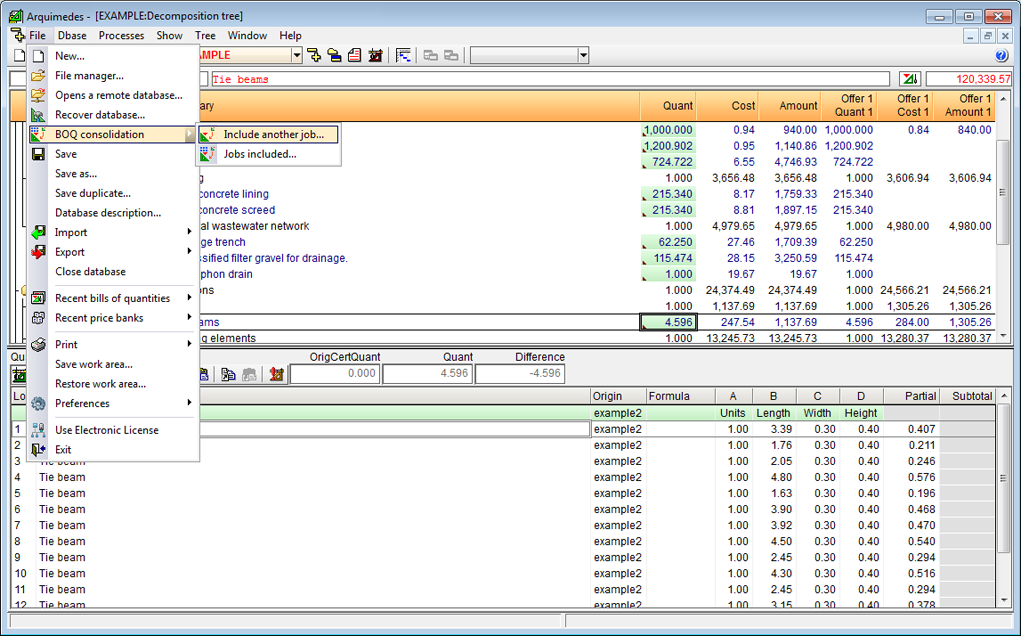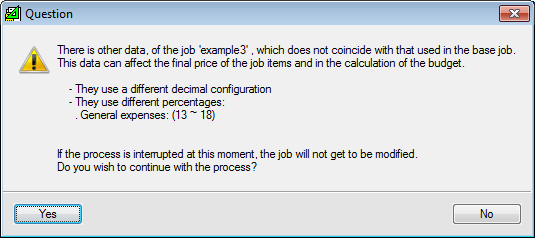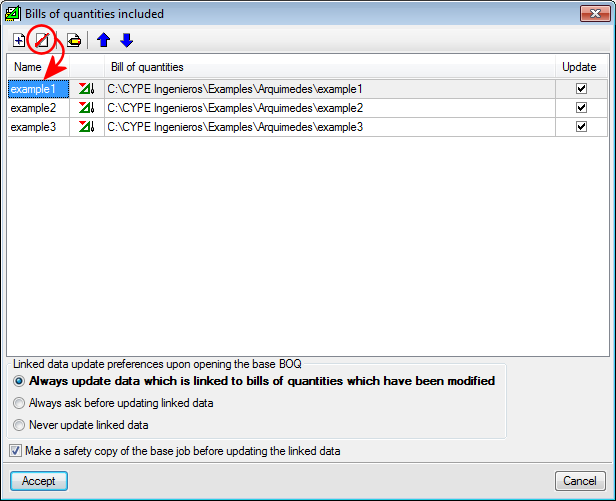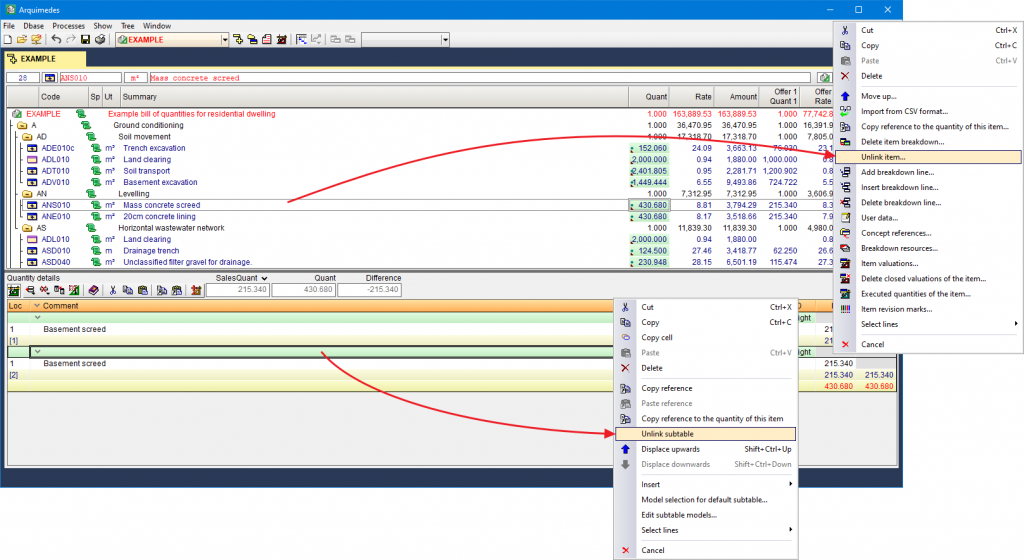The BOQ consolidation module of Arquimedes allows for several existing bills of quantities to be included in a base bill of quantities (which can be empty), and maintain the link between the incorporated items and their original bills of quantities. This way, the base bill of quantities can be updated with the changes which are carried out in the original bills of quantities.
This module is especially useful for managing two bill of quantity elaboration methods: Joining of partial bills of quantities generated by other CYPE programs or Joining of partial bills of quantities carried out by different project collaborators.
How the BOQ consolidation module works
All the units of a job from a bill of quantities or several bills of quantities (linked bills of quantities) can be imported to an existing bill of quantities (which can be empty), referred to as the base bill of quantities. The items that are imported in this way are linked to their original bills of quantities, which allows for the base bill of quantities to be updated after any changes have been undertaken in the linked bills of quantities. The different options to update the bill of quantities are described in the Updating modifications carried out in linked bills of quantities section.
The items that are linked to other bills of quantities have a small triangle in the bottom left-hand corner of the cell containing the quantity (Decomposition tree view). This way, they can easily be distinguished from those that are not linked to other bills of quantities. Additionally, the quantities of each linked job contain a details table which includes, within a subtable, the quantities that come from the linked bill of quantities. The quantities table contains a column labelled Origin. The rows of the subtable linked to another bill of quantities are displayed in this column, with a reference identifying the job from which the quantities originate.
The tools managing the import and linking to other bills of quantities in the base bill of quantities can be activated using the BOQ consolidation option within the File menu. These are:
- Include another bill of quantities
Using this option, a bill of quantities can be selected so to include it in the current bill of quantities. - Bills of quantities included
This option opens the Bills of quantities included dialogue box. This window displays a list of the bills of quantities included in the current bill of quantities. From this dialogue box, the following operations can be carried out:- Include another bill of quantities in the current bill of quantities
- Delete the link of the linked bill of quantities selected from the list
- Edit the name and description of the linked bill of quantities selected from the list
- Change the order of the linked bills of quantities of the list
- Update linked data of the current bill of quantities
- Configure the updating preferences of the linked data upon opening the base bill of quantities
- Make a safety copy of the base job before updating the linked data
Updating modifications carried out in linked bills of quantities
If the linked bills of quantities are modified, the items of the base bill of quantities which are linked to those bills of quantities can be updated in two ways:
- Data update when the base bill of quantities is opened
Each time the base bill of quantities is opened, Arquimedes updates the job items linked to other bills of quantities (only from the bills of quantities that have been modified since the last update). This update is carried out in accordance with the option that has been selected in the Bills of quantities included dialogue box (File > BOQ consolidation > Jobs included).
These options allow users to carry out the following:- Always update data which is linked to bills of quantities which have been modified
- Always ask before updating linked data
- Never update linked data
This option is useful for the user to be able to carry out the update only when deemed necessary, using the method detailed below.
- Data update whilst the base bill of quantities is open
Any bills of quantities that are linked to the current base bill of quantities are displayed in the Included bill of quantities dialogue box (File > BOQ consolidation > Jobs included). Each of them has a box (Update column), which the user can activate to update the data of the selected bills of quantities, by pressing the Accept button of this dialogue box. This update is independent of the options located below the bill of quantities table, which only allow users to configure the update when the base bill of quantities is opened.
Each box of the Update column will be activated by default if the corresponding linked bill of quantities has been modified. Users can activate or deactivate these boxes as they wish, allowing them to update only the data of a specific bill of quantities and not of all those present.
Contradiction control between the base bill of quantities and the imported bills of quantities
When a bill of quantities is imported into the base bill of quantities, it is logical that they both have the same configuration, and that the imported concepts come from the same price bank and with the same conditions. In other words, both bills of quantities must have the same number of decimal places and percentages used, repeated unit items (description and cost), and the items that have the same code must also coincide (in their decomposition and in the yield of their unit items).
If these indications are not applied, Arquimedes will inform the user of the existing contradictions between the base bill of quantities and the imported bill of quantities. The program will offer the user the possibility of not carrying out the import so to correct the differences. If the user decides to continue with the import, the program elaborates a report detailing all the contradictions, which can be printed or exported to different file formats.
It is also possible that an item that has been imported from the linked bill of quantities already exists in the base bill of quantities. This is not a contradiction. In this case, Arquimedes includes a quantities subtable in the detailed quantities of the base bill of quantities, containing the quantities of the item of the imported bill of quantities. A reference is present within the subtable indicating the linked bill of quantities from which it comes from.
Unlink items from the original bills of quantities
Items that have been imported from other bills of quantities can be unlinked from the base bill of quantities.
- Deleting the link to a bill of quantities for all the items imported from other bills of quantities
The bill of quantities to be deleted is selected from the list in the Bills of quantities included dialogue box, then by clicking on the Delete selected element from the list button, the connection to the selected bill of quantities is deleted and all the items imported from that bill of quantities will be unlinked. If one of those items has links to several bills of quantities, only the link to the selected bill of quantities will be deleted.
Before unlinking, the program informs the user that the link of all the items related to the bill of quantities selected from the list is going to be deleted. The user has three options:- Unlink quantities
The existing reference within the quantities subtable of the selected bill of quantities will be deleted, without altering the quantity details. Therefore, there is no possibility of updating any changes in the base job which occur in the unlinked bill of quantities.
- Delete quantities
In addition to eliminating the reference and possibility to update (Unlink quantities option), the quantity details related to the selected bill of quantities are also deleted. However, details of other bills of quantities which could be linked or unlinked details are not altered. The job item will not be deleted in any case, even if the total resulting quantity is zero.
- Delete quantities and the item without quantities
Deletes the quantity details linked to the selected bill of quantities and the items that have zero quantities.
- Unlink quantities
- Delete the links between an item and all the bills of quantities to which it is linked
Items that are linked to one or more bills of quantities, when clicked on using the right mouse button in the Decomposition tree window, will display a menu containing, amongst other options, Unlink item. If this option is selected, all the links the chosen job may have with other bills of quantities will be deleted, as well as the reference to each of them which exists in each quantities subtable. Neither the item nor its quantities are deleted. - Delete the link between an item and one of the bills of quantities to which it is linked
A quantities subtable for each linked bill of quantities is present in the quantity details table of an item linked to one or more bills of quantities. By right-clicking the header of one of these subtables, a menu appears containing the Unlink subtable option. This option deletes the link and reference to the chosen item with respect to the bill of quantities to which the selected subtable belongs. Neither the item nor its quantities are deleted.
Re-link items
Users have three options to re-link a job to a deleted connection:
- Using the Undo option (Undo button of the toolbar)
Please note that the Undo option only undoes a number of consecutive changes (File > Preferences > Undo/Redo Settings) and only those made since the job was last opened. In other words, if the base bill of quantities is closed after unlinking, and is then re-opened, the Undo option cannot be used to re-link the data that has been unlinked before closing the base bill of quantities. - Recover the safety copy
The safety copy that has been carried out before deleting the link can be recovered (Processes > Safety copies of the database) if the option: Make a safety copy of the base job before updating the linked data within the Bills of quantities included dialogue box (File > BOQ consolidation > Jobs included) has not been deactivated. - Re-link the bill of quantities
If the link to a bill of quantities has been deleted using the Delete the quantities and the item without quantities option, the bill of quantities can be re-linked correctly using the Include another job option or from the Bills of quantities included dialogue box (File > BOQ consolidation).
Please note that a bill or quantities can always be re-linked, but if the quantities which were previously linked have not been deleted (process which can be carried out automatically using the Delete the quantities and the item without quantities option), the quantities of the bill of quantities that is re-linked will be duplicated. It is also recommended that items that have no quantities be deleted before re-linking the bill of quantities, which is also done automatically using the Delete the quantities and the item without quantities option.
Useful for managing the creation of the complete bill of quantities of the job based on different partial bills of quantities
The BOQ Consolidation module is a very useful tool for managing the elaboration methods of a bill of quantities. It also includes the following:
- Joining bills of quantities carried out by different project collaborators
Several collaborators may be involved in a single project where each person is in charge of providing the documents required for the part of the project they are responsible for (structure, installations, acoustic and thermal performance of the building, etc.). This collaboration implies the existence of several partial bills of quantities for the same project, which should be properly combined.
However, someone must coordinate the creation of the complete bill of quantities by joining the different partial BOQ's that have been created. The person combining these bills of quantities must pay special attention to the configuration options that have been selected for each of them (decimals and percentages) and control any modifications that are made to the partial bills of quantities after the combination has begun.
The BOQ Consolidation module controls any possible contradictions between the configuration of the base bill of quantities and the partial bill of quantities, and also allows for the base bill of quantities to be updated at any time after the partial bills of quantities have been modified. These properties make the BOQ Consolidation module an essential tool for appropriate coordination when preparing the complete bill of quantities of the project, based on various partial bills of quantities.
Other features
In order to access further features offered by the program, there are several modules that can be found on the "Arquimedes modules" webpage.









